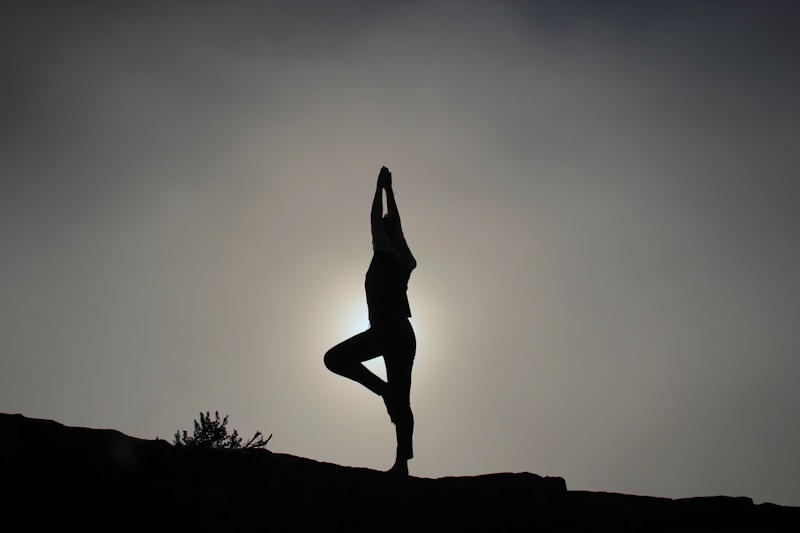Poppy Pickles recalls her introduction to yoga through antenatal yoga, and reflects that the lessons she learnt then are still useful in her practice today. From the beginnings of getting to know her body from the inside out, to the practical implications post-pregnancy, many lessons can be learned from pregnancy yoga.
The very first yoga class I ever attended was a pregnancy yoga class. It was set in the crypt of a church and was a calm, safe space, guided by an experienced and caring teacher, Lolly Stirk, one of the founding members of Yogabirth. In those lessons the outside world receded, and I began to get in touch with my body and the little body growing within it.
Antenatal yoga was an incredible way of preparing for labour. Whilst I felt a lot of anxiety around labour and birth, yoga prepared my body and allowed my mind to take a step back, allowing my body to do the job it does naturally. I was lucky enough to have a straightforward labour and my son was born with hardly any medical intervention.
Once I fell pregnant again I felt compelled to go to pregnancy yoga classes again, and found it was even more beneficial the second time round, when running around after a toddler gave me even less time to connect with my pregnancy.
Once my children were a bit older I was drawn back to yoga as a way of reclaiming my body, and since then it has become an integral part of my life. But while thinking back to those early days of yoga, I began to think that the lessons of pregnancy yoga shouldn’t be limited to the brief nine months of pregnancy. Pregnancy yoga isn’t just a preparation for childbirth, but a preparation for the rest of your yoga practice. Here are five lessons I learnt from pregnancy yoga that I still value and use in my yoga practice today.
Trust In Your Body
The number one lesson of pregnancy yoga for me was learning to trust in my body. As intellectual Western creatures we tend to distrust our bodies, and look to medical science to explain our bodies to us. But as the German philosopher Friedrich Nietzsche said, ‘There is more wisdom in your body than your deepest philosophy”. It’s just that before you can access that deeply instinctive wisdom, the conscious mind has to take a step back, which is not something it’s used to doing.
Yoga holds the key to learning this difficult art. By constantly bringing the mind back to the body in ever more subtle ways, we learn to tame the monkey mind. This is crucial for labour, when the body has to release itself to the waves of contractions without being limited by fear or any external pressure.
It’s also a lesson that we need to keep re-learning over and over again. As a yoga teacher trainee I’m constantly being told to come out of my head and into my body – for example, rather than constantly taking notes, instead repeat what I’m taught with my body. Unless we bring yoga into our bodies, we don’t ever really learn.
Create Space To Rest
The antenatal yoga classes I went to were like external wombs of care. When preparing for the journey of motherhood we need to create safe spaces in the packed schedules of our modern lives for conscious rest.
Post-birth, and long into the adventure of parenthood, making space in my schedule for physical and mental rest, either through a restorative yoga practice, or a short pranayama practice is a saving grace in my life.
Also, being on a yoga teacher training course puts huge demands on my body. The temptation is there to push the body to its limits, to keep progressing. But, as the yoga teacher and author Bobby Clennell says, ‘an overzealous and aggressive yoga practice can strain the body just as much as working out on machines in the gym.’
Use the Breath
The breath is a lifeline during labour, a tool for enduring the contractions, a way of softening the body and a natural, life-affirming rhythm.
At a recent yoga class, we spent the lesson concentrating purely on the breath. We moved into Warrior 2, and then focused on the breath, and found that we could stay in the pose for far longer than usual. The breath had softened our body, and taken our minds away from the perceived pain of holding the pose…
Stop Thinking
…Which leads me onto the next useful lesson – to stop thinking.
This is really the flip side of trusting your body, but it bears repeating. As B.K.S. Iyengar puts it in his book ‘Light on Life’:
‘So often what prevents us from living an admirable life is the chattering of our minds, which pester us with long outdated doubts and despair.’
In labour the mind needs to take a step back in order to let the body take charge. In my daily yoga practice the conscious mind presents all sorts of criticisms, anxieties, distractions and inane chatter. By using the breath as a guide you can bring the attention to one point in the body – pratyahara, or one-pointed attention. This is the next stage in the journey of yoga.
Labour and enjoyment are not two words that you’d usually put together. But pregnancy yoga gave me a positive childbirth. The emphasis was on the joy of the miraculous transformation from pregnant woman to mother and child, rather than the pain of contractions. Of course, it doesn’t mean it’s all fun and games, and there were parts of the labour that were distinctly un-enjoyable, but I was focused enough on the present moment to really experience childbirth.
The same can be said for yoga! Especially while doing the yoga teacher training course. There are parts of it that are hard, painful, scary. But there is real joy too, if you can be in the present moment long enough to find it.












